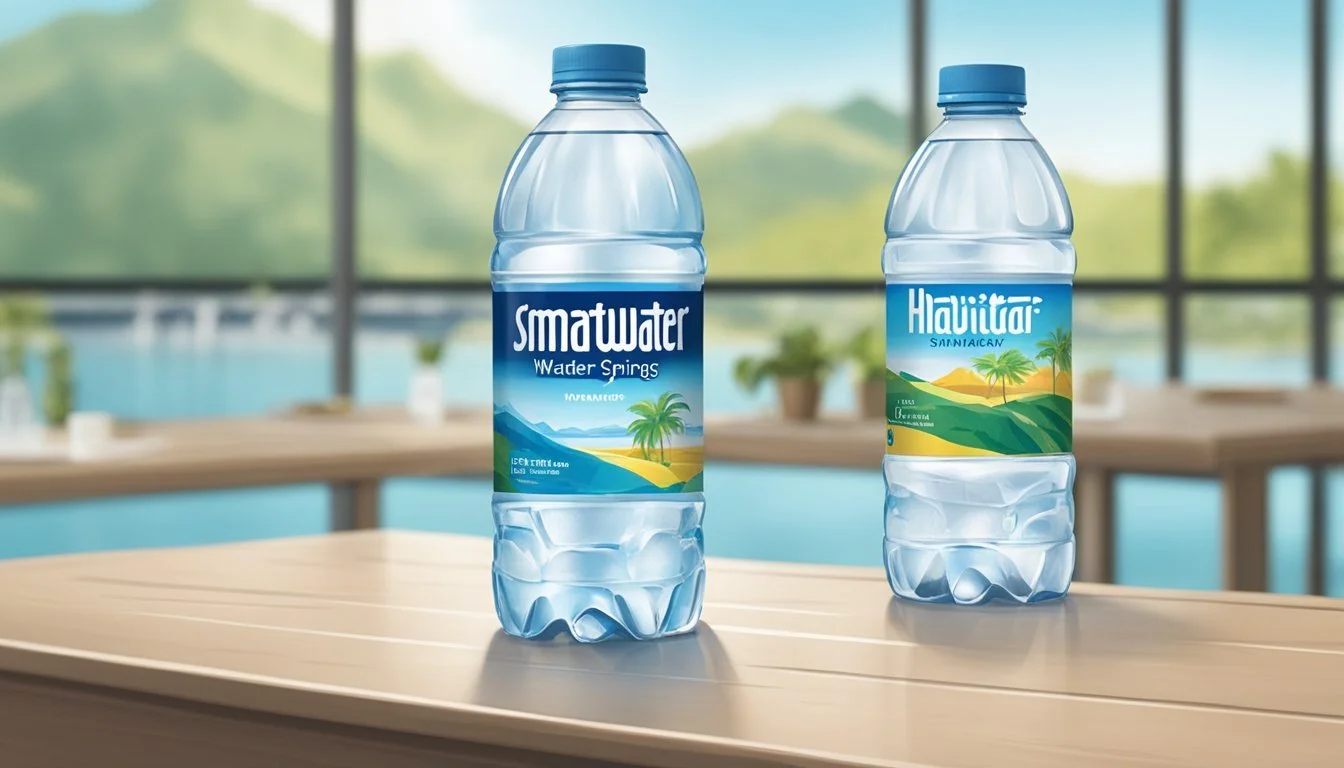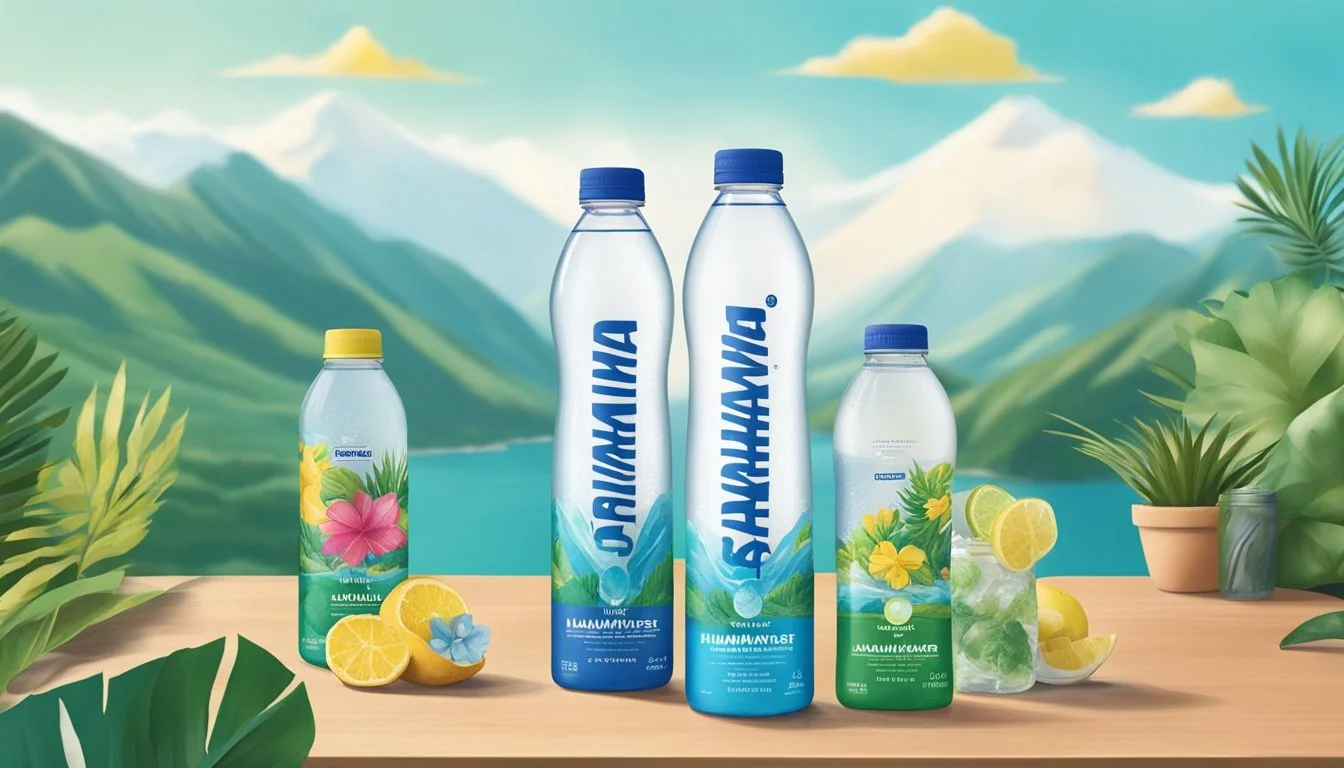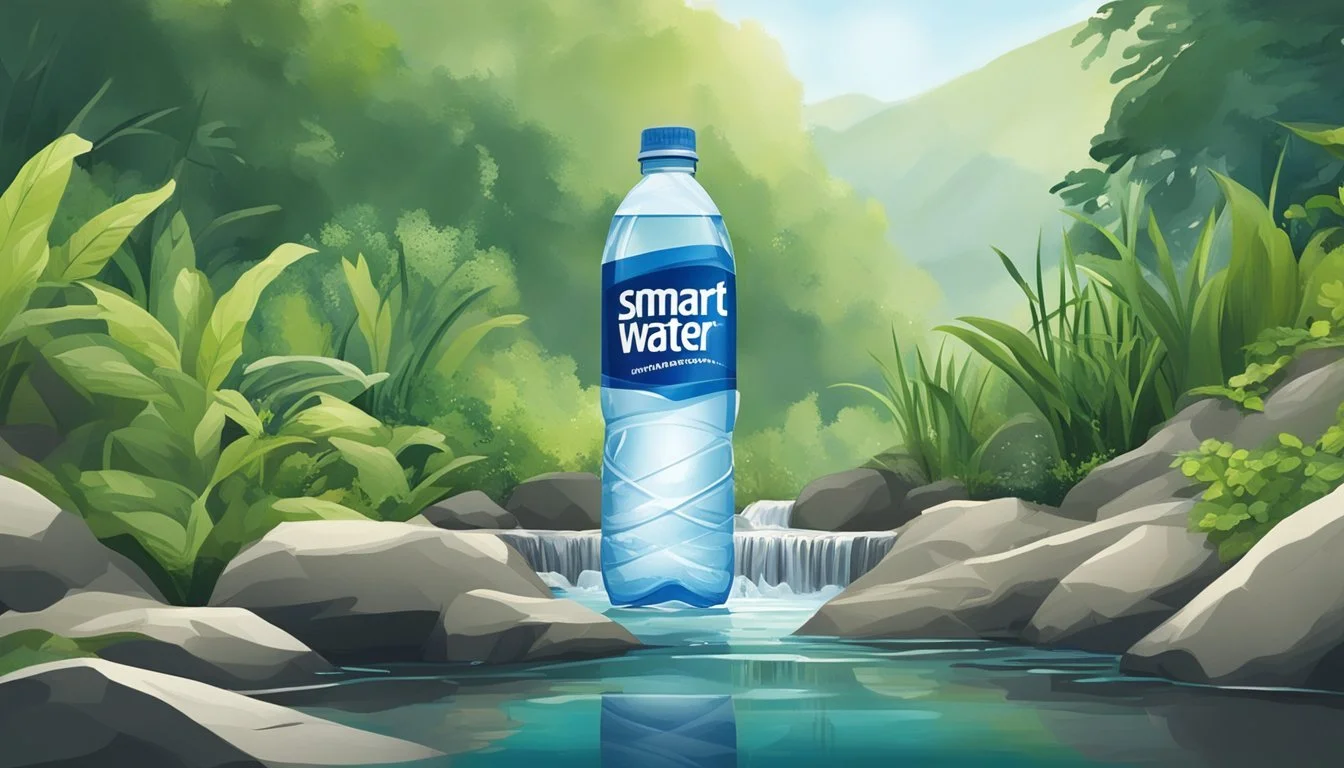Smartwater vs. Hawaiian Springs
A Comparative Analysis of Quality and Taste
Comparing Smartwater and Hawaiian Springs can give consumers insight into which water may suit their preferences and needs better. Smartwater, known for its vapor-distilled purity and added electrolytes, offers a clean and crisp taste, positioning itself as an enhanced hydration option.
On the other hand, Hawaiian Springs prides itself on being naturally sourced from Hawaii's artesian wells, offering a unique, smooth taste that reflects the purity of its origin. Both brands represent different approaches to bottled water, with Smartwater focusing on refined purification and Hawaiian Springs emphasizing natural sourcing.
For those who prioritize added minerals and a consistent, crisp flavor, Smartwater might be the better choice. If a pristine, natural source and the allure of Hawaiian origins are more appealing, Hawaiian Springs stands out.
Understanding Bottled Water
Bottled water comes in many forms and understanding its nuances can help consumers make informed choices. This section explores what defines bottled water, the different types, and gives insight into the industry.
What Defines Bottled Water?
Bottled water is any water that is sealed in a bottle and intended for human consumption. It's sourced from a variety of places, including springs, wells, or surface water supplies. Each brand may treat and process their water differently to ensure safety and enhance taste. The U.S. FDA regulates bottled water to ensure safety and proper labeling. Key quality checks include testing for contaminants and verification of mineral content.
Types of Bottled Water
Several types of bottled water are available:
Spring Water: Sourced from underground formations where water flows naturally to the surface.
Purified Water: Treated through processes like distillation, deionization, or reverse osmosis to remove impurities.
Mineral Water: Contains a minimum level of minerals naturally sourced from a spring or well and is not altered in mineral content.
Alkaline Water: Treated to increase its pH level, often marketed for its potential health benefits.
Distilled Water: Boiled into vapor and condensed back into liquid, removing minerals and impurities.
Each type offers unique properties catering to consumers' preferences and health considerations.
The Bottled Water Industry
The bottled water industry is substantial and diverse, with numerous brands competing globally. Major players include Aquafina, Dasani, Fiji Water, and Evian. They differentiate through sourcing, treatment methods, and marketing strategies. Market dynamics are influenced by consumer trends towards health, sustainability, and convenience. Global regulations ensure safety, but practices vary by region. Investment in eco-friendly packaging and sustainable sources is increasing as environmental concerns grow. This industry continues to expand, adapting to technological advancements and changing consumer expectations.
Comparing Smartwater and Hawaiian Springs
Both Smartwater and Hawaiian Springs boast unique features that cater to different consumer preferences. Factors such as brand history, reputation, pricing, and accessibility heavily influence their market presence.
Brand History and Reputation
Smartwater is a product of Glaceau, which is owned by Coca-Cola. Since its introduction in 1996, Smartwater has been known for its vapor-distilled water with added electrolytes for a crisp, clean taste. Coca-Cola's backing has helped Smartwater secure a strong presence in the bottled water market.
Hawaiian Springs, on the other hand, is sourced from Hawaiian aquifers. This water is marketed for its purity and natural mineral content. As a niche brand, it emphasizes its origin and natural filtration process, appealing to consumers seeking authenticity and quality from natural sources.
Price and Accessibility
Smartwater is widely available due to Coca-Cola's extensive distribution network. It can be found in supermarkets, convenience stores, and online retailers. Smartwater is moderately priced, making it accessible to a broad range of consumers.
Hawaiian Springs is less ubiquitous and often found in select health food stores and specialty markets. This limited availability can make it more challenging for consumers to purchase. The price point for Hawaiian Springs tends to be higher, reflecting its premium positioning and natural sourcing.
Source and Filtration Processes
Smartwater and Hawaiian Springs differ significantly in their sources and filtration processes, impacting their taste and perceived purity.
Smartwater: Vapor Distillation
Smartwater starts with municipal water as its source. The company employs a vapor distillation process, which involves heating the water until it becomes vapor. This vapor is then condensed back into liquid, leaving impurities behind.
This distillation method is highly effective in removing contaminants, including microorganisms and chemicals.
To enhance the taste and nutritional value, Smartwater adds electrolytes like calcium, magnesium, and potassium. These added minerals contribute to the brand's distinct clean and crisp taste profile.
Reverse osmosis and ultraviolet light are sometimes used in additional purification steps for even higher purity levels.
Hawaiian Springs: Natural Filtration
Hawaiian Springs sources its water from natural aquifers located in Hawaii. These waters are naturally filtered through layers of volcanic rock, which adds a unique mineral content to the water.
The filtration process includes the slow passage through porous lava, contributing to its high silica content and balanced pH levels.
Hawaiian Springs ensures further safety by using ozone sterilization to eliminate any remaining bacteria and pathogens without altering the water's natural properties.
This minimal intervention approach preserves the natural taste and mineral profile, making it appealing for those who prefer less processed water.
In contrast to industrial methods like reverse osmosis, the reliance on natural filtration sets Hawaiian Springs apart in the bottled water market.
Composition and Health Benefits
Smartwater and Hawaiian Springs offer unique compositions and health benefits. Both brands focus on providing clean, refreshing water but differ in factors like pH levels and electrolyte content, which influence taste and potential health benefits.
pH Levels and Alkalinity
Smartwater markets its water through offerings like Smartwater Alkaline, which boasts a higher pH level aimed at those seeking the purported benefits of alkaline water. Typically, Smartwater Alkaline has a pH of 9.5, which is higher than neutral water. This elevated pH level can help counteract acidity in the body, potentially improving overall well-being.
Hawaiian Springs, on the other hand, often advertises its natural alkalinity sourced from the Kea’au aquifer. The water usually has a natural pH level of around 7.7 to 8.0, slightly alkaline due to the volcanic minerals it absorbs naturally. This makes Hawaiian Springs water potentially beneficial for maintaining balanced body pH levels without added ingredients.
Electrolytes for Taste and Function
Smartwater is known for including added electrolytes such as calcium, magnesium, and potassium, which are meant to enhance the water's taste and provide additional functional benefits. These electrolytes can assist in maintaining hydration during physical activity and help replenish what the body loses through sweat.
In contrast, Hawaiian Springs focuses on its natural mineral content, with its water naturally enriched by the volcanic rocks it filters through. This includes minerals such as calcium and magnesium, which not only contribute to a clean and refreshing taste but also provide subtle health benefits. These minerals are crucial for bone health and muscle function, offering a naturally balanced hydration option.
Both brands aim to stand out by their unique approaches to enhancing water composition, thereby catering to different consumer preferences and needs.
Taste Profile
Taste is a critical aspect when comparing bottled waters. While Smartwater offers a distinctly purified taste with added electrolytes, Hawaiian Springs boasts a unique mineral-rich flavor derived from its natural filtration process. Both brands provide distinct experiences appealing to different preferences.
Water Taste Comparison
Smartwater is known for its clean, crisp taste. The water undergoes vapor distillation, a purification process that removes impurities. Electrolytes such as calcium, magnesium, and potassium are then added for taste, giving it a slightly enhanced mineral flavor without overwhelming the palate.
Hawaiian Springs, on the other hand, leverages the natural filtration of lava rock in Hawaii, resulting in a water that is smooth and subtly sweet. It contains naturally occurring minerals, including silica, which contributes to its unique flavor profile. This water offers a more earthy and natural taste compared to the purified and enhanced flavor of Smartwater.
Conducting a Taste Test
Conducting a thorough taste test involves assessing various attributes. A good approach is to start by evaluating the mouthfeel. Smartwater tends to feel lighter on the tongue, and its mineral additives provide a faint but perceptible taste. Hawaiian Springs, conversely, feels slightly denser, with a more complex, mineral-rich taste.
Next, consider mineral flavor. Taste testers often find Smartwater's added electrolytes give it a balanced mineral taste without any one mineral standing out. Hawaiian Springs' natural minerals, particularly silica, offer a smoother, subtly sweet profile that can be more appealing to those preferring less processed water.
For best results, ensure all samples are tasted at room temperature to better discern the subtleties in flavor and mouthfeel. Use neutral foods like plain crackers to cleanse the palate between tastes. This controlled approach helps highlight the distinct qualities each brand brings to the table.
Environmental Impact and Sustainability
Smartwater and Hawaiian Springs differ significantly in their approach to environmental impact and sustainability. The most important factors to consider include bottle production, recycling processes, and the effects of water extraction on ecosystems.
Bottle Production and Recycling
Smartwater uses plastic bottles for its products. These bottles contain BPA, a chemical of concern in terms of both human health and environmental impact. Recycling rates for plastic can be low, as the process can be resource-intensive and not all plastic is recyclable.
Hawaiian Springs also employs plastic, but it has been exploring more sustainable options, including the potential for boxed water. Boxed water reduces reliance on plastic and focuses on more renewable materials. Improved recycling rates for alternative materials can lessen their environmental footprint.
Using more sustainable materials and enhancing recycling processes are essential steps for both brands to mitigate their environmental impacts.
Water Extraction and Ecosystems
Smartwater sources its water through municipal sources, essentially local tap water that undergoes further purification. This approach minimizes the ecological disruption during extraction. However, it still involves logistical challenges and carbon emissions associated with bottling and distribution.
Hawaiian Springs sources its water from natural springs, which can raise concerns about the depletion of local water resources. Responsible water management is vital to avoid negative impacts on local ecosystems and to sustain the aquifers.
Efforts to balance extraction rates with natural replenishment are crucial for the sustainability of Hawaiian Springs. Both brands have opportunities to improve by investing in eco-friendly practices and reducing their carbon footprints during the extraction and bottling process.
Consumer Convenience and Lifestyle
When evaluating Smartwater and Hawaiian Springs, aspects like packaging, portability, and accessibility play pivotal roles. These factors directly influence consumer convenience and daily lifestyle integration.
Packaging and Portability
Smartwater is known for its sleek, elongated bottle design that fits comfortably in most cup holders and backpacks. This makes it a practical choice for those who are constantly on the move. The plastic materials are lightweight yet sturdy, enhancing its portability.
Hawaiian Springs, on the other hand, offers water in aesthetically pleasing bottles that often reflect their premium branding. Although visually appealing, the design might be less practical for everyday carry, especially in tight or small spaces. It's better suited for home use or special occasions.
Accessibility and Everyday Use
Smartwater is widely available in supermarkets, convenience stores, and online platforms. Its high accessibility means consumers rarely struggle to find or purchase this brand. It is often a staple in homes and offices due to its consistent quality and trusted reputation.
In contrast, Hawaiian Springs might be harder to locate, with availability largely confined to select stores and regions. This may pose a challenge for everyday use, but for consumers seeking a unique taste experience, it's worth the search. Hawaiian Springs occupies a niche market, appealing more to those who appreciate the premium and exotic nature of the brand.
Both brands offer unique advantages in terms of consumer convenience and lifestyle adaptation, catering to different needs and preferences.
Regulations and Standards
When considering bottled water, it’s crucial to evaluate the regulations and standards that govern its quality. This ensures the water is safe and meets specific criteria for purity and quality assurance.
FDA Guidelines for Bottled Water
The FDA regulates bottled water as a packaged food product in the United States. It sets standards that bottled water must meet, including limits on contaminants and labeling requirements.
The FDA's standards often mirror the EPA's regulations for tap water, ensuring bottled water is held to similar safety levels. Specific contaminants monitored include:
Microbiological: E.g., E. coli
Chemical: E.g., lead
Physical: E.g., particulate matter
Bottled water companies must adhere to these guidelines, providing regular testing and maintaining records to prove compliance.
International Standards and Quality Assurance
International standards also play a significant role. Organizations like the World Health Organization (WHO) and the Codex Alimentarius Commission establish global guidelines.
These standards emphasize:
Purity: Ensuring the water is free from harmful contaminants
Labeling: Accurate representation of contents
Quality assurance practices: Regular testing and verification
Bottled water brands like Smartwater and Hawaiian Springs often employ these practices to meet both local and international standards. By adhering to these regulations, they ensure the health benefits and safety of their products are maintained across various markets.
Conclusion
Smartwater and Hawaiian Springs offer distinct features and benefits that cater to different preferences.
Smartwater is known for its purified and vapor-distilled process, enhanced with electrolytes for taste. It appeals to those who prioritize consistency in flavor and hydration benefits.
Hawaiian Springs, sourced directly from Hawaii, emphasizes a natural and refreshing taste, derived from its volcanic filtration. It often resonates with individuals who prefer a premium and natural source.
Brand Reputation:
Smartwater: Widely recognized and trusted.
Hawaiian Springs: Valued for its unique sourcing and exotic appeal.
Personal Preference:
Some consumers prefer the clean taste of Smartwater.
Others opt for the natural purity of Hawaiian Springs.
Here’s a quick comparison:
Feature Smartwater Hawaiian Springs Source Purified vapor-distilled Volcanic spring Taste Enhanced with electrolytes Naturally refreshing Brand Reputation Highly recognized Premium yet less mainstream Ideal For Consistency, hydration Natural purity, exotic experience
He or she must weigh these factors to determine the best bottled water for their needs. Both brands provide quality options but shine in different aspects.
More About Smartwater
Core Hydration vs Smartwater: Which Bottled Water is Better?
Icelandic Glacial vs Smartwater: Which Bottled Water is Better?
Mountain Valley Spring Water vs Smartwater: Which Bottled Water is Better?
Nestle Pure Life vs Smartwater: Which Bottled Water is Better?
San Pellegrino vs Smartwater: Which Bottled Water is Better?
Smartwater vs Aqua Carpatica: Which Bottled Water is Better?
Smartwater vs Cascade Mountain: Which Bottled Water is Better?
Smartwater vs Crystal Geyser: Which Bottled Water is Better?
Smartwater vs Hawaii Volcanic: Which Bottled Water is Better?
Smartwater vs Kirkland Signature: Which Bottled Water is Better?
Smartwater vs Richard's Rainwater: Which Bottled Water is Better?
Smartwater vs Solan de Cabras: Which Bottled Water is Better?
Smartwater vs Talking Rain AQA: Which Bottled Water is Better?
Smartwater vs Whole Foods 365: Which Bottled Water is Better?
Smartwater vs Whole Foods Italian Still Mineral water: Which Bottled Water is Better?
More About Hawaiian Springs
Acqua Pana vs Hawaiian Springs: Which Bottled Water is Better?
Aqua Carpatica vs Hawaiian Springs: Which Bottled Water is Better?
Aquafina vs Hawaiian Springs: Which Bottled Water is Better?
Arrowhead vs Hawaiian Springs: Which Bottled Water is Better?
Boxed Water vs Hawaiian Springs: Which Bottled Water is Better?
Castle Rock vs Hawaiian Springs: Which Bottled Water is Better?
Core Hydration vs Hawaiian Springs: Which Bottled Water is Better?
Deer Park vs Hawaiian Springs: Which Bottled Water is Better?
Essentia vs Hawaiian Springs: Which Bottled Water is Better?
Hawaiian Springs vs 1907water: Which Bottled Water is Better?
Hawaiian Springs vs 7-Select: Which Bottled Water is Better?
Hawaiian Springs vs Alkaline88: Which Bottled Water is Better?
Hawaiian Springs vs Antipodes: Which Bottled Water is Better?
Hawaiian Springs vs Big Chill: Which Bottled Water is Better?
Hawaiian Springs vs BodyArmor: Which Bottled Water is Better?
Hawaiian Springs vs Cascade Mountain: Which Bottled Water is Better?
Hawaiian Springs vs CBD Living: Which Bottled Water is Better?
Hawaiian Springs vs Crystal Geyser: Which Bottled Water is Better?
Hawaiian Springs vs Crystal Lake: Which Bottled Water is Better?
Hawaiian Springs vs Essence pH10: Which Bottled Water is Better?
Hawaiian Springs vs Hawaii Volcanic: Which Bottled Water is Better?
Hawaiian Springs vs Kirkland Signature: Which Bottled Water is Better?
Hawaiian Springs vs Liquid Death: Which Bottled Water is Better?
Hawaiian Springs vs Mananalu: Which Bottled Water is Better?
Hawaiian Springs vs Open Water: Which Bottled Water is Better?
Hawaiian Springs vs Proud Source: Which Bottled Water is Better?
Hawaiian Springs vs Pure Life: Which Bottled Water is Better?
Hawaiian Springs vs Purely Sedona: Which Bottled Water is Better?
Hawaiian Springs vs Refreshe: Which Bottled Water is Better?
Hawaiian Springs vs Richard's Rainwater: Which Bottled Water is Better?
Hawaiian Springs vs Simple Truth: Which Bottled Water is Better?
Hawaiian Springs vs Solan de Cabras: Which Bottled Water is Better?
Hawaiian Springs vs Talking Rain AQA: Which Bottled Water is Better?
Hawaiian Springs vs The Well: Which Bottled Water is Better?
Hawaiian Springs vs Tru Alka: Which Bottled Water is Better?
Hawaiian Springs vs Weird Water: Which Bottled Water is Better?
Hawaiian Springs vs Whole Foods 365: Which Bottled Water is Better?
Hawaiian Springs vs Whole Foods Italian Still Mineral water: Which Bottled Water is Better?
Ice Mountain vs Hawaiian Springs: Which Bottled Water is Better?
Icelandic Glacial vs Hawaiian Springs: Which Bottled Water is Better?
Just Water vs Hawaiian Springs: Which Bottled Water is Better?
Mountain Valley Spring Water vs Hawaiian Springs: Which Bottled Water is Better?
Nestle Pure Life vs Hawaiian Springs: Which Bottled Water is Better?
Poland Spring vs Hawaiian Springs: Which Bottled Water is Better?
San Pellegrino vs Hawaiian Springs: Which Bottled Water is Better?
Topo Chico vs Hawaiian Springs: Which Bottled Water is Better?
Zephyrhills vs Hawaiian Springs: Which Bottled Water is Better?






